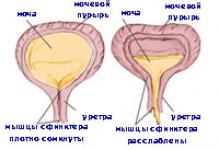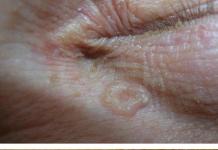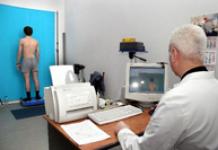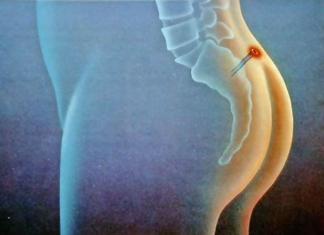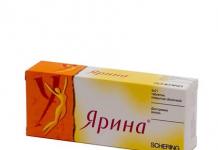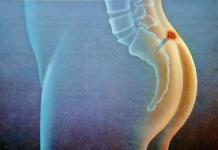– a condition accompanied by a sudden critical increase in blood pressure, against the background of which neurovegetative disorders, disturbances of cerebral hemodynamics, and the development of acute heart failure are possible. A hypertensive crisis occurs with headaches, noise in the ears and head, nausea and vomiting, visual disturbances, sweating, lethargy, sensitivity and thermoregulation disorders, tachycardia, heart failure, etc. Diagnosis of a hypertensive crisis is based on indicators blood pressure, clinical manifestations, auscultation data, ECG. Measures to relieve a hypertensive crisis include bed rest, a gradual controlled decrease in blood pressure using medications (calcium antagonists, ACE inhibitors, vasodilators, diuretics, etc.).

General information
A hypertensive crisis is regarded in cardiology as an emergency condition that occurs with a sudden, individually excessive jump in blood pressure (systolic and diastolic). Hypertensive crisis develops in approximately 1% of patients with arterial hypertension. A hypertensive crisis can last from several hours to several days and lead not only to the occurrence of transient neurovegetative disorders, but also to disorders of cerebral, coronary and renal blood flow.
At hypertensive crisis the risk of severe life-threatening complications (stroke, subarachnoid hemorrhage, myocardial infarction, rupture of aortic aneurysm, pulmonary edema, acute renal failure, etc.) increases significantly. In this case, damage to target organs can develop both at the height of a hypertensive crisis and with a rapid decrease in blood pressure.

Causes
Typically, a hypertensive crisis develops against the background of diseases occurring with arterial hypertension, but it can also occur without a previous persistent increase in blood pressure.
Hypertensive crises occur in approximately 30% of patients with hypertension. They are most common in women experiencing menopause. Often, a hypertensive crisis complicates the course of atherosclerotic lesions of the aorta and its branches, kidney diseases (glomerulonephritis, pyelonephritis, nephroptosis), diabetic nephropathy, periarteritis nodosa, systemic lupus erythematosus, nephropathy of pregnancy. A crisis course of arterial hypertension can be observed with pheochromocytoma, Itsenko-Cushing's disease, and primary hyperaldosteronism. Enough common cause Hypertensive crisis is caused by the so-called “withdrawal syndrome” - rapid cessation of taking antihypertensive drugs.
In the presence of the above conditions, the development of a hypertensive crisis can be provoked by emotional excitement, meteorological factors, hypothermia, physical exercise, alcohol abuse, excess dietary salt intake, electrolyte imbalance (hypokalemia, hypernatremia).
Pathogenesis
The mechanism of development of hypertensive crises in various pathological conditions is not the same. The basis of a hypertensive crisis in hypertension is a violation of neurohumoral control of changes in vascular tone and activation of the sympathetic influence on the circulatory system. A sharp increase in arteriolar tone contributes to a pathological increase in blood pressure, which creates additional stress on the mechanisms of regulation of peripheral blood flow.
Hypertensive crisis with pheochromocytoma is caused by an increase in the level of catecholamines in the blood. In acute glomerulonephritis, we should talk about renal (decreased renal filtration) and extrarenal factors (hypervolemia) that determine the development of the crisis. In the case of primary hyperaldosteronism, increased secretion of aldosterone is accompanied by a redistribution of electrolytes in the body: increased excretion of potassium in the urine and hypernatremia, which ultimately leads to an increase in peripheral vascular resistance, etc.
Thus, despite the various reasons, common points in the mechanism of development of various variants of hypertensive crises are arterial hypertension and dysregulation of vascular tone.
Classification
Hypertensive crises are classified according to several principles. Taking into account the mechanisms of increased blood pressure, hyperkinetic, hypokinetic and eukinetic types of hypertensive crisis are distinguished. Hyperkinetic crises are characterized by an increase in cardiac output with normal or decreased peripheral vascular tone - in this case, an increase in systolic pressure occurs. The mechanism of development of a hypokinetic crisis is associated with a decrease in cardiac output and a sharp increase in peripheral vascular resistance, which leads to a predominant increase in diastolic pressure. Eukinetic hypertensive crises develop with normal cardiac output and increased peripheral vascular tone, which entails a sharp jump in both systolic and diastolic pressure.
Based on the reversibility of symptoms, an uncomplicated and a complicated version of a hypertensive crisis are distinguished. The latter is spoken of in cases where a hypertensive crisis is accompanied by damage to target organs and is the cause of hemorrhagic or ischemic stroke, encephalopathy, cerebral edema, acute coronary syndrome, heart failure, dissection of aortic aneurysm, acute myocardial infarction, eclampsia, retinopathy, hematuria, etc. Depending on the location of complications that developed against the background of a hypertensive crisis, the latter are divided into cardiac, cerebral, ophthalmological, renal and vascular.
Taking into account the prevailing clinical syndrome, neuro-vegetative, edematous and convulsive forms of hypertensive crises are distinguished.
Symptoms of hypertensive crisis
A hypertensive crisis with a predominance of neuro-vegetative syndrome is associated with a sharp, significant release of adrenaline and usually develops as a result of a stressful situation. A neurovegetative crisis is characterized by excited, restless, nervous behavior of patients. Increased sweating, flushing of the skin of the face and neck, dry mouth, and hand tremors are noted. The course of this form of hypertensive crisis is accompanied by pronounced cerebral symptoms: intense headaches (spread out or localized in the occipital or temporal region), a feeling of noise in the head, dizziness, nausea and vomiting, blurred vision (“veil”, “flickering of flies” before the eyes) . In the neurovegetative form of a hypertensive crisis, tachycardia, a predominant increase in systolic blood pressure, and an increase in pulse pressure are detected. During the period of resolution of the hypertensive crisis, frequent urination is observed, during which an increased volume of light urine is released. The duration of a hypertensive crisis ranges from 1 to 5 hours; There is usually no threat to the patient's life.
The edematous or water-salt form of hypertensive crisis is more common in overweight women. The crisis is based on an imbalance of the renin-angiotensin-aldosterone system, which regulates systemic and renal blood flow, the constancy of blood volume and water-salt metabolism. Patients with the edematous form of hypertensive crisis are depressed, apathetic, drowsy, and poorly oriented in the environment and in time. At external inspection notices the pallor skin, puffiness of the face, swelling of the eyelids and fingers. Typically, a hypertensive crisis is preceded by a decrease in diuresis, muscle weakness, and interruptions in heart function (extrasystoles). In the edematous form of a hypertensive crisis, there is a uniform increase in systolic and diastolic pressure or a decrease in pulse pressure due to a large increase in diastolic pressure. A water-salt hypertensive crisis can last from several hours to a day and also has a relatively favorable course.
Neuro-vegetative and edematous forms of hypertensive crisis are sometimes accompanied by numbness, a burning sensation and tightening of the skin, a decrease in tactile and pain sensitivity; in severe cases - transient hemiparesis, diplopia, amaurosis.
The most severe course is characteristic of the convulsive form of hypertensive crisis (acute hypertensive encephalopathy), which develops when the regulation of the tone of cerebral arterioles is disturbed in response to a sharp increase in systemic blood pressure. The resulting cerebral edema can last up to 2-3 days. At the height of a hypertensive crisis, patients experience clonic and tonic convulsions and loss of consciousness. For some time after the end of the attack, patients may remain unconscious or disoriented; Amnesia and transient amaurosis persist. The convulsive form of a hypertensive crisis can be complicated by subarachnoid or intracerebral hemorrhage, paresis, coma and death.
Diagnosis of hypertensive crisis
One should think about a hypertensive crisis when blood pressure rises above individually tolerable values, relatively sudden development, and the presence of symptoms of a cardiac, cerebral and vegetative nature. An objective examination may reveal tachycardia or bradycardia, rhythm disturbances (usually extrasystole), percussion expansion of the boundaries of relative dullness of the heart to the left, auscultatory phenomena (gallop rhythm, accent or splitting of the second sound over the aorta, moist rales in the lungs, hard breathing, etc.).
Blood pressure can increase to varying degrees; as a rule, during a hypertensive crisis it is above 170/110-220/120 mm Hg. Art. Blood pressure is measured every 15 minutes: initially on both arms, then on the arm where it is higher. When registering an ECG, the presence of abnormalities is assessed heart rate and conductivity, left ventricular hypertrophy, focal changes.
To implement differential diagnosis and assessing the severity of a hypertensive crisis, specialists may be involved in examining the patient: cardiologist, ophthalmologist, neurologist. The scope and feasibility of additional diagnostic studies (EchoCG, REG, EEG, 24-hour blood pressure monitoring) is determined individually.
Treatment of hypertensive crisis
Hypertensive crises of various types and genesis require differentiated treatment tactics. Indications for hospitalization in a hospital include intractable hypertensive crises, repeated crises, and the need for additional research aimed at clarifying the nature of arterial hypertension.
If blood pressure rises critically, the patient is provided with complete rest, bed rest, and a special diet. The leading place in relieving a hypertensive crisis belongs to emergency drug therapy aimed at lowering blood pressure and stabilizing vascular system, protection of target organs.
To lower blood pressure values in uncomplicated hypertensive crisis, blockers are used calcium channels(nifedipine), vasodilators (sodium nitroprusside, diazoxide), ACE inhibitors (captopril, enalapril), ß-blockers (labetalol), imidazoline receptor agonists (clonidine) and other groups of drugs. It is extremely important to ensure a smooth, gradual decrease in blood pressure: by approximately 20-25% of initial values during the first hour, over the next 2-6 hours - to 160/100 mm Hg. Art. Otherwise, with an excessively rapid decrease, the development of acute vascular accidents can be provoked.
Symptomatic treatment of a hypertensive crisis includes oxygen therapy, administration of cardiac glycosides, diuretics, antianginal, antiarrhythmic, antiemetic, sedatives, analgesics, and anticonvulsants. It is advisable to conduct hirudotherapy sessions and distraction procedures (hot foot baths, heating pads on the feet, mustard plasters).
Possible outcomes of treatment of hypertensive crisis are:
- improvement of condition (70%) – characterized by a decrease in blood pressure by 15-30% of the critical level; a decrease in the severity of clinical manifestations. There is no need for hospitalization; selection of adequate antihypertensive therapy on an outpatient basis.
- progression of hypertensive crisis (15%) – manifested by an increase in symptoms and the addition of complications. Requires hospitalization in a hospital.
- lack of effect from treatment – there is no dynamics of blood pressure reduction, clinical manifestations They don’t grow, but they don’t stop either. A change in medication or hospitalization is necessary.
- complications of an iatrogenic nature (10-20%) – occur with a sharp or excessive decrease in blood pressure (arterial hypotension, collapse), accession side effects from medicines(bronchospasm, bradycardia, etc.). Hospitalization for the purpose of dynamic observation or intensive care is indicated.
Prognosis and prevention
When providing timely and adequate medical care The prognosis for hypertensive crisis is conditionally favorable. Cases of death are associated with complications arising from a sharp rise in blood pressure (stroke, pulmonary edema, heart failure, myocardial infarction, etc.).
To prevent hypertensive crises, one should adhere to the recommended antihypertensive therapy, regularly monitor blood pressure, limit the amount of salt and fatty foods consumed, monitor body weight, avoid drinking alcohol and smoking, avoid stressful situations, and increase physical activity.
In case of symptomatic arterial hypertension, consultations with specialized specialists - a neurologist,
Definition of the concept
In the literature there are various definitions of the concept of “hypertensive crisis” (HC). In most cases, it is defined as a rapid increase in diastolic blood pressure (> 120 mm Hg), sometimes systolic blood pressure (> 220 mm Hg). In some cases, hypertensive disorders include a rapid increase in blood pressure to high levels that are unusual for a given patient, although they do not reach the specified values. This is apparently due to the fact that GCs can develop according to different scenarios. The rate of rise in blood pressure can determine the severity of hypertension to a greater extent than blood pressure numbers, since with a rapid increase in blood pressure, the mechanisms of autoregulation do not have time to turn on. Many authors agree that the blood pressure level is not a leading indicator in the diagnosis of hypertension, especially in cases of target organ damage.
According to the definition of JNC VI (1997), JNC VII (2003), HC is a condition with a pronounced increase in blood pressure, accompanied by the appearance or worsening clinical symptoms and requiring a rapid, controlled reduction in blood pressure to prevent damage to target organs.
The working group on hypertension of the Ukrainian Society of Cardiologists defines hypertension as a sudden significant increase in blood pressure from normal or higher level, which is almost always accompanied by the appearance or intensification of disorder from target organs or autonomic nervous system.
It is known that hypertensive crisis (HC) as a manifestation (or complication) of arterial hypertension (AH) occurs in approximately 1% of people suffering from hypertension. Practice shows that very often doctors consider any increase in blood pressure (BP) as hypertension, which is not always justified. At the same time, the Civil Code, being emergency, can become a source of complications that surpass them in significance and urgency.
HA refers to a wide range of clinical situations manifested by increased blood pressure and target organ damage, although most often they occur in hypertensive patients, and the development of HA does not correlate with the level of initial blood pressure.
Causes of the disease
From possible reasons GCs can be distinguished as exogenous - acute stressful situations, accumulation of a critical mass of chronic stressful situations, unfavorable meteorological factors, excessive salt consumption; endogenous - dysfunction of the endocrine glands, hypersympathicotonia, increased levels of catecholamines, hypersensitivity of adrenergic receptors, disruption of the depressor system, level of cardiac output, local changes in the function of the vascular wall, abrupt withdrawal of antihypertensive drugs, exacerbation of cervicothoracic osteochondrosis, increase in circulating blood volume.
Mechanisms of occurrence and development of the disease (pathogenesis)
Each individual factor, and in most cases their combination, disrupts the synchronization of central and peripheral hemodynamics with simultaneous dysfunction of the diencephalic region. According to I. Shkhvatsabai, GC is a manifestation of violations of general and local mechanisms of adaptation to stress factors against the background of changes in the reactivity of blood vessels to pressor influences.
Currently, there is no generally accepted, legalized classification of GC due to the variety of manifestations and complications that may accompany GC.
There are many forms of HA. A.P. Golikov (1976) proposed dividing hypertensive crises depending on the values of peripheral vascular resistance and stroke volume of the heart, according to the types of systemic hemodynamics: hyperkinetic type, in which an increase in blood pressure occurs due to an increase in stroke volume; hypokinetic type, in which an increase in blood pressure occurs due to a sharp increase in peripheral vascular resistance; eukinetic type, in which an increase in blood pressure occurs against the background of normal or slightly increased stroke volume and moderately increased peripheral vascular resistance.
M.S. Kushakovsky (1982) identified three forms of crises: neurovegetative, hydrosalt and convulsive.
1. Neurovegetativnth crisis. Occurs on early stages GB. It is characterized by a violation of systolic blood pressure with unchanged or slightly increased diastolic blood pressure. This suggests that this clinical situation is based on ejection hypertension with simultaneous excitation of the autonomic nervous system. In the clinic: blood pressure increases very quickly due to an increase in adrenaline, tremors, palpitations, skin hyperemia, agitation occur, headache, nausea, polyuria.
2. Water-salt crisis. Appears in later stages of the disease. The content of norepinephrine increases in the blood. It develops gradually, slowly over several hours or days. It is most often based on an increase in circulating blood volume and an increase in peripheral resistance. In the clinical picture, two options are distinguished: a) cardiac - pain in the heart area, shortness of breath, increasing circulatory failure of the right and (or) left type, possible pulmonary edema, SA, MI, angina pectoris; b) cerebral - adynamia, headache, visual disturbances, drowsiness, nausea, vomiting, spots before the eyes, lethargy, paresthesia, PNMC, strokes. Very often in the clinic there are combinations of these options. Common to water-salt GC are pallor of the skin, autonomic disorders, and a uniform increase in systolic and (or) only diastolic blood pressure.
3. Convulsive (epileptiform) or hypertensive encephalopathy. Such crises occur more often in severe hypertension with high blood pressure, usually the diastolic blood pressure increases (above 110-130 mm Hg), with secondary arterial hypertension (late toxicosis of pregnancy, kidney disease, endocrine system). Patients experience an intense pulsating headache, it grows and becomes bursting. Severe anxiety and agitation occur. Some patients scream in pain. As a rule, in patients this pain is accompanied by nausea, repeated vomiting, slow pulse, and visual disturbances. On examination, meningeal signs and disc edema are revealed. optic nerve. Stunning, coma, and clonic-tonic convulsions rapidly increase. The pathogenesis of this suffering lies in the breakdown of autoregulation of cerebral vessels with peripheral vasodilation, a significant increase in intracranial blood supply, impaired microcirculation, vascular permeability and cerebral edema.
However, the most acceptable and used in the guidelines of many countries and cardiological societies is the GC classification, which distinguishes complicated and uncomplicated variants of the course of the crisis.
Clinical picture of the disease (symptoms and syndromes)
The Civil Code criteria are:
Sudden onset;
Significant increase in blood pressure;
The appearance or intensification of symptoms from target organs.
International and domestic recommendations give preference to classification based on the severity of clinical symptoms and the risk of developing severe (even fatal) life-threatening complications. These conditions are divided into complicated and uncomplicated GC.
Complicated HA(critical, emergency, life-threatening) is accompanied by the development of acute clinically significant and potentially fatal damage to target organs, which requires emergency hospitalization (usually in an intensive care unit) and immediate reduction of blood pressure using parenteral antihypertensive drugs.
Complicated HA is spoken of when diagnosing the following conditions associated with high blood pressure, that is, with damage to target organs: acute hypertensive encephalopathy, acute cerebrovascular accident, acute left ventricular failure (cardiac asthma, pulmonary edema), acute coronary syndrome (MI, unstable angina) ), dissecting aortic aneurysm, severe arterial bleeding, eclampsia.
Uncomplicated GC(non-critical, urgent) occurs with minimal subjective and objective symptoms against the background of an existing significant increase in blood pressure. It is not accompanied by acute development of target organ damage and requires a decrease in blood pressure within several hours without the need for emergency hospitalization. Uncomplicated HA is characterized by low-symptomatic hypertension in the following conditions associated with elevated blood pressure:
Severe and malignant hypertension without acute complications, extensive burns;
Drug-induced hypertension;
Perioperative hypertension;
Acute glomerulonephritis with severe hypertension;
Crisis in scleroderma.
If we consider GCs, which usually occur in the initial period of the disease, then these are so-called first-order crises. HCs of the first type, or first order, are characterized by a rapid onset with pronounced autonomic disturbances and are accompanied by headaches, nausea, weakness, tremors in the body, palpitations, a feeling of hot flashes, psychomotor agitation and frequent urination. This type crises are handled very emotionally, but do not lead to serious consequences. Treatment of uncomplicated crises does not require an urgent reduction in blood pressure; tablet forms of drugs are more often used, and always in combination with drugs aimed at normalizing the psycho-emotional state.
The main recommendations and treatment algorithms are devoted specifically to complicated crises. This is caused by a great danger to the patient’s health and life during the development of a second-order crisis—a crisis with target organ damage. Based on target organ damage during the development of complicated GC, the following classification was carried out. Depending on the damage to the organ, crises are divided into GCs with the development of acute encephalopathy, acute cerebrovascular accident (both hemorrhagic and ischemic), acute coronary syndrome, acute left ventricular failure, dissection of the aortic aneurysm, acute renal failure, acute arrhythmic syndrome, eclampsia, papilledema with hemorrhages.
Clinical conditions requiring immediate reduction in blood pressure (not lower than normal for each individual patient):
- hypertensive encephalopathy,
- OLZHN,
- acute aortic dissection,
- eclampsia,
- condition after coronary artery bypass surgery,
- some cases of hypertension, combined with an increase in the level of catecholamines circulating in the blood (pheochromocytoma, hypertension upon withdrawal of clonidine, administration of sympathomimetics),
- hypertension due to intracerebral hemorrhage,
- acute subarachnoid hemorrhage,
- acute cerebral infarctions,
- unstable angina or AMI.
Conditions requiring a slow decrease in blood pressure (12 - 24 hours):
- high diastolic hypertension without complications.
- malignant hypertension without complications,
- hypertension in the postoperative period.
Cerebral vascular paroxysms (CVP) in hypertension:
CSP in hypertension is manifested by headaches, which are based on changes in the cerebral systemic or local blood flow in combination with a violation of the rheological properties of the blood. These changes lead to decompensation of cerebral circulation, are paroxysmal in nature and are not accompanied by a significant increase in blood pressure compared to the patient’s usual level. Emerging CSPs, unlike GCs, are not accompanied by focal or extensive cerebral symptoms and often resolve spontaneously (V. Ruskin, 1993). When providing assistance for CSP, it is necessary to take into account the stage and course of headache. In all cases, CSP blood pressure must be reduced very slowly over several hours. “Pure” CSPs occur during emotional stress (use of antipsychotics) and the hyperadrenergic variant of headache (visken, transicor, small doses of clonidine). In other cases, when the health of a hypertensive patient with signs of fluid retention worsens, diuretics, capoten, and vasodilators are used. For isolated systolic hypertension, it is advisable to use small doses of diuretics in combination with calcium antagonists or ACE inhibitors (Capoten). It is necessary to reduce blood pressure slowly, since its normalization causes a deterioration in cerebral and coronary blood flow.
It should also be said about isolated systolic hypertension in elderly people.
This pathology is associated with damage to the arterial bed and decreased elasticity of the great vessels. Characteristic clinical sign is an isolated increase in systolic pressure with low or normal diastolic pressure. The symptoms of this paroxysm are vague and in most cases very scarce. In the treatment of this paroxysm, a “mild” decrease in blood pressure and vascular drugs are necessary: aminophylline, cavinton, a nicotinic acid, trental, troxevasin (rutazides).
In the practice of a doctor of any profile there are patients with a compensatory increase in blood pressure.
Typically, this situation develops in response to deterioration of coronary, cerebral, renal, pulmonary and other blood flow or hypoxia. Most often, an increase in blood pressure (initially as a compensatory rise, and with a prolonged increase in blood pressure - symptomatic hypertension) occurs in osteochondrosis of the cervical-thoracic spine with transient vertebrobasilar insufficiency; with a transient disorder of cerebral and coronary circulation; for renal ischemia due to hypoxia and hypercapnia during acute obstructive processes in the lungs. In all these and similar cases, it should be remembered that therapeutic measures should be aimed at treating the underlying disease, and not at rapidly reducing blood pressure, as this can lead to severe disturbances in regional blood flow and deterioration of the condition. With a compensatory increase in blood pressure, as with CSP, a violation of the rheological properties of the blood occurs, and therefore, regardless of the cause, it is necessary to include disaggregants and anticoagulants in therapy.
Diagnosis of the disease
From a diagnostic point of view, the criteria for GC are:
1) individually rapid and high increase in blood pressure;
2) complaints of a general vegetative, cardiac or cerebral nature.
GC can develop against the background of any stages of hypertension or symptomatic hypertension.
Treatment of the disease
In the treatment of uncomplicated GCs It is recommended to use predominantly oral medications that provide a gradual decrease in blood pressure over 24-48 hours. Treatment of uncomplicated GC is carried out on an outpatient basis; emergency hospitalization is not required. In some cases, patients with uncomplicated GC are hospitalized.
Indications for hospitalization in this category of patients may include the following factors:
Uncertainty of the diagnosis, the need for special (usually invasive) studies to clarify the nature of hypertension;
Difficulty in selecting drug therapy at the prehospital stage (frequent GCs, therapy-resistant hypertension). After relief of GC, correction of planned therapy for hypertension is carried out. Choice of tactics therapeutic measures(drug, route of administration, expected rate, magnitude of blood pressure reduction) directly depends on the severity of HA and the presence of complications. Crucial importance in the treatment of GC is both the achievement of the absolute level of blood pressure and the correct interpretation of the patient’s complaints and symptoms.
When treating GC, it is necessary to pay attention to the pathological mechanisms underlying hypertension. Thus, in case of a neurovegetative crisis, taking into account the underlying excitation of the central nervous system, autonomic centers and ejection hypertension, it is advisable to begin treatment with the use of sedatives in combination with beta blockers. During a water-salt crisis, the use of diuretics in combination with peripheral vasodilators and sympatholytics is in the foreground. In these cases, corinfar and (or) clonidine have a good effect. Droperidol and aminazine, administered intramuscularly or intravenously depending on the blood pressure level, were effective. If there is a threat of stroke or CVD, IM must be used fast-acting drugs. These include pentamine, administered intravenously in a slow stream, or, even better, intravenously by drip. The latter method of administration makes it possible to control blood pressure levels. For controlled hypotension, it is advisable to use arfonade or drip administration of aminazine, sodium nitropruside. Labetalol also has a good hypotensive effect, acting simultaneously on alpha and beta receptors and blocking them.
The reason for the lack of effect of antihypertensive therapy may be:
- hypervolemia (insufficient dose of diuretics and (or) excessive salt intake);
- excessive intake of diuretics, which leads to a decrease in blood volume and the activity of renin and catecholamines;
- salt depletion in patients with interstitial kidney damage.
Complicated GC are an indication for emergency hospitalization of the patient.
Conservative treatment
There is no consensus on treatment tactics; Ukrainian recommendations differ significantly from foreign ones. Abroad, drugs such as dibazole, papaverine, nifedipine, etc., are not used to relieve hypertension. In our country, unfortunately, these drugs are among the most common medicines at the prehospital and hospital stages of GC treatment.
Emergency measures should be aimed at reducing the increased work of the left ventricle, eliminating peripheral vasoconstriction and hypervolemia, cerebral ischemia (especially in the convulsive version), acute coronary or heart failure.
Complicated HA is considered a direct indication for hospitalization and rapid initiation of antihypertensive therapy using the intravenous route of drug administration.
The rate of blood pressure reduction in complicated hysterectomy:
Within 30-120 minutes by 15-25%;
Within 2-6 hours the blood pressure level is 160/100 - 150/90 mm Hg. Art.;
A sharp decrease in blood pressure to normal values contraindicated, it can lead to hyperperfusion and ischemia, including necrosis. In acute cerebrovascular accident, the rate of blood pressure reduction should be slow.
The presence of a dissecting aortic aneurysm requires a rapid reduction in blood pressure by 25% within 5-10 minutes, the target blood pressure for a dissecting aortic aneurysm is 110-100 mm Hg. Art.
In case of complicated GCs, therapy, as a rule, depends on the damage to certain target organs. As mentioned above, with this type of HA they are used intravenous administration drugs whose effect begins within a few minutes.
When administering antihypertensive drugs intravenously, it is necessary to carefully monitor the patient’s condition, if it worsens due to a decrease in blood pressure infusion therapy should be stopped. Most often, with an excessive decrease in blood pressure, increased pain in the chest, the appearance/increase in the severity of ischemic changes on the electrocardiogram, worsening cerebral symptoms, and impaired consciousness can be observed.
Complicated hypertensive crises
Hypertensive encephalopathy — recommended drugs: ebrantil, labetalol, clevidipine, nicardipine, esmolol. Not recommended: nitroprusside, hydralazine. Recommendations for treatment tactics: decrease in mean blood pressure by 25% within 8 hours.
Ischemic stroke — recommended drugs: ebrantil, labetalol, clevidipine, nicardipine. Recommendations for treatment tactics: antihypertensive therapy is not carried out at systolic blood pressure (SBP)< 220 мм рт.ст., и диастолическом АД (ДАД) < 120 мм рт.ст. Исключение составляют пациенты, которым проводится фибринолитическая терапия. АД у таких пациентов должно быть ниже: систолическое < 185 мм рт.ст., а диастолическое < 105 мм рт.ст. в течение 24 часов.
Hemorrhagic stroke — recommended drugs: ebrantil, labetalol, clevidipine, nicardipine, esmolol. Not recommended: nitroprusside, hydralazine. Recommendations for treatment tactics: treatment is based on clinical and radiological data on the severity of the enlargement intracranial pressure. During the first 24 hours after the onset of symptoms with increased intracranial pressure, the average blood pressure is maintained< 130 мм рт.ст. (систолическое АД < 180 мм рт.ст.), у пациентов без повышения внутричерепного давления поддерживается среднее АД в пределах < 110 мм рт.ст. (систолическое АД < 160 мм рт.ст.).
Subarachnoid hemorrhage — recommended drugs: ebrantil, labetalol, clevidipine, nicardipine, esmolol. Not recommended: nitroprusside, hydralazine. Recommendations for treatment tactics: systolic blood pressure< 160 мм рт.ст., пока аневризма не оперирована или поддерживается спазм мозговых сосудов. Необходимо использовать прием таблетированного нимодипина для предотвращения отсроченных неврологических дефектов ишемического генеза. Прием нимодипина не заменяет внутривенного введения гипотензивных препаратов.
Aortic dissection - recommended drugs: ebrantil, labetalol, clevidipine, nicardipine, nitroglycerin, nitroprusside (only with beta blockers), esmolol; painkillers (morphine). Not recommended: in cases of severe valvular regurgitation or suspected cardiac tamponade, beta blockers are excluded. Recommendations for treatment tactics: systolic blood pressure< 110 мм рт.ст., при отсутствии данных относительно гипоперфузии органов предпочтительно комбинированное лечение с применением наркотических анальгетиков (морфин), бетаблокаторов (лабеталол, эсмолол) и вазодилататоров (никардипин, нитроглицерин, нитропруссид). В качестве альтернативы бетаблокаторам могут выступать антагонисты кальция (верапамил, дилтиазем).
Acute coronary syndrome — recommended drugs: ebrantil, labetalol, esmolol, nitroglycerin. Recommendations for treatment tactics: antihypertensive therapy is carried out when systolic blood pressure exceeds 160 mm Hg and diastolic blood pressure > 100 mm Hg. Reduction of blood pressure by 20-30% from the initial level. Fibrinolytic therapy is not indicated for blood pressure levels > 185/100 mmHg; the contraindication is relative.
Acute heart failure — recommended drugs: urapidil, nitroglycerin, enalaprilat. Recommendations for treatment tactics: antihypertensive therapy with vasodilators is always carried out in combination with diuretics (furosemide, torsemide) at a systolic blood pressure of 140 mm Hg. Intravenous nitroglycerin or sublingual administration is preferred.
Cocaine intoxication/pheochromocytoma - recommended drugs: ebrantil, diazepam, phentolamine, nitroprusside, nitroglycerin. Not recommended: use of beta blockers before using alpha blockers. Recommendations for treatment tactics: elevated blood pressure and tachycardia during cocaine intoxication rarely require specific treatment. The first-line drugs are alpha-blockers, especially for cocaine-associated acute coronary syndrome. Treatment of a crisis with pheochromocytoma is similar to that for cocaine intoxication. Beta blockers may be added to control baseline blood pressure only after alpha blockers have been administered.
Preeclampsia — recommended drugs: ebrantil, hydralazine, labetalol, nifedipine. Not recommended: nitroprusside, enalaprilat, esmolol. Recommendations for treatment tactics: for eclampsia and preeclampsia, systolic blood pressure should be< 160 мм рт.ст. и диастолическое АД < 110 мм рт.ст. в предродовый и родовый период. У пациентов с уровнем тромбоцитов < 100 000 клеток на 1 мм3 АД должно быть менее 150/100 мм рт.ст. При эклампсии и преэклампсии обязательно внутривенное введение сульфата магния во избежание схваток.
Preoperative hypertension — recommended drugs: ebrantil, nitroprusside, nitroglycerin, esmolol. Treatment recommendations: The target preoperative BP is within 20% of the patient's usual BP, unless there is a possibility of life-threatening arterial bleeding. Preoperative use of beta blockers is the first choice in patients undergoing vascular procedures or in patients at intermediate or high risk for cardiac complications.
This condition is dangerous due to the development of very severe complications, such as stroke, pulmonary edema, and acute heart failure. Therefore, it is important to provide help as early as possible.
Classification of hypertensive crises
- uncomplicated;
- complicated.
In the first case, there are no serious dysfunctions of the heart, brain or kidneys. After taking the medication, the blood pressure level returns to normal within a few hours.
A complicated crisis occurs much less frequently and is characterized by damage to target organs. It can be:
- encephalopathy (brain dysfunction) with loss of memory or consciousness;
- stroke;
- subarachnoid hemorrhage;
- acute coronary syndrome;
- pulmonary edema;
- dissecting aortic aneurysm.
There are several other conditions in which an increase in blood pressure to high levels is considered dangerous:
- taking drugs, such as cocaine or amphetamine
- brain injury
- preeclampsia or eclampsia during pregnancy.
Causes
- untreated arterial hypertension;
- improper use of medications for hypertension;
- diseases thyroid gland, kidneys, adrenal glands;
- heart diseases;
- preeclampsia in pregnant women;
- taking cocaine or amphetamine;
- head injuries;
- severe burns;
- nicotine/alcohol abuse;
- stress.
Signs and symptoms of hypertensive crisis
An uncomplicated crisis can only manifest itself as an increase in blood pressure. In more severe cases:
- headache;
- drowsiness;
- visual impairment;
- confusion;
- lightheadedness, nausea;
- increasing pain in the chest;
- increasing shortness of breath;
- swelling.
Diagnostics
During the examination, the doctor will ask several questions to provide adequate assistance. You will need to tell about all the medications you are taking, as well as food additives or herbal preparations. There is no need to hide drug use if it was. The doctor will also learn about the medical history - whether the condition arose for the first time or whether it is recurring.
In addition to one-time pressure measurements, the following diagnostic methods are used:
- daily blood pressure monitoring;
- examination of the fundus to detect swelling and hemorrhages;
- clinical blood and urine tests;
- computed tomography (CT) to rule out stroke.
Treatment of hypertensive crisis
The goal is a smooth decrease in blood pressure. In general, the rate of pressure reduction should not be more than 25% in the first 2 hours. Then, no more than a day later, it is recommended to return the pressure level to the original level.
Help with uncomplicated hypertensive crisis
Treatment can be done at home. The drugs are prescribed mainly in tablets, less often in injections. Expedient dosage forms with a rapid onset of effect and a short elimination period:
- captopril 25 mg;
- nifedipine 10 mg;
- moxonidine 0.2-0.4 mg;
- propranolol 10-40 mg.
The tablet must be dissolved or placed under the tongue. All of these medications have contraindications and side effects which should be discussed with your doctor. If the crisis occurs for the first time or is difficult to treat and often recurs, then a decrease in blood pressure and further selection of drugs is carried out in the hospital.
Help with complicated hypertensive crisis
If there are symptoms of damage to the brain, heart or kidneys, then it is necessary to urgently call ambulance. Treatment in this case is carried out either in emergency cardiology or in intensive care in a cardiology or therapeutic department. If a stroke is suspected, the patient is taken to the neurointensive care unit or intensive care unit of the neurological department. Main symptoms of stroke:
- inability to move or severe weakness in the muscles on one side of the body;
- difficulty moving the tongue, lips, sagging half of the face;
- inability to speak clearly.
In the case of a stroke, a rapid and significant decrease in pressure can aggravate the situation, so drugs are carefully dosed. In case of dissecting aortic aneurysm or acute left ventricular failure, on the contrary, the pressure must be reduced quickly: within the first 10 minutes - by 25% of what was recorded.
When providing assistance, drugs are administered intravenously. It can be:
- enalaprilat 1.25 mg in 1 ml;
- nitroglycerin concentrate for infusion 1 mg in 1 ml;
- sodium nitroprusside 30 mg in 5 ml and 50 mg in 2 ml;
- metoprolol solution 1 mg in 1 ml;
- furosemide in ampoules of 20 mg in 2 ml;
- pentamine 50 mg in 1 ml.
The choice of a specific drug, dose and method of administration is made only by the doctor. Thus, in case of heart damage with the development of acute coronary syndrome, nitroglycerin is advisable. For acute encephalopathy caused by increased blood pressure - sodium nitroprusside, for pheochromocytoma - phentolamine, and for acute left ventricular failure - enalaprilat and furosemide.
Prevention of hypertensive crisis
- Maximum control chronic diseases - diabetes mellitus, diseases of the thyroid gland and adrenal glands.
- Measure blood pressure twice a day, morning and evening, while sitting. The recommendation applies to those people who have already been diagnosed with hypertension. It is advisable to record the results in an observation diary and then show it to your doctor.
- Eating more fruits, vegetables, whole grain bread, legumes, lean fish and meat, and dairy products. Limit salt and hydrogenated fats. As recommended by your doctor, you need to eat more foods containing potassium and magnesium.
- Weight control. Even a small loss in obesity can normalize blood pressure.
- Develop a physical activity plan with your doctor.
- Limit alcohol consumption to one drink per day for women and two for men. 1 serving is approximately 150 ml of wine, 350 ml of beer or 45 ml of liquor.
- Stop smoking.
Sources
- Hypertensive Crisis: When You Should Call 9-1-1 for High Blood Pressure, updated 30 November 2017, http://www.heart.org/HEARTORG/Conditions/HighBloodPressure/AboutHighBloodPressure/Hypertensive-Crisis UCM 301782_Article.jsp#.WVonE4jyjIU
- High blood pressure (hypertension), Overview, Mayo Clinic, http://www.mayoclinic.org/diseases-conditions/high-blood-pressure/basics/definition/con-20019580?p=1
- Clinical guidelines for the diagnosis and treatment of arterial hypertension (Developed by experts of the Russian Medical Society on arterial hypertension. Approved at the meeting of the plenum of the Russian Medical Society on arterial hypertension on November 28, 2013 and the specialized commission on cardiology on November 29, 2013) https://www.cardioweb. ru/files/Klinicheskie rekomendacii/Diagnostika i treatment arterialnoj_gipertonii.docx
- High Blood Pressure and Hypertensive Crisis, Reviewed by James Beckerman, MD, FACC on October 10, 2017, WebMd
Extremely high blood pressure is defined as 180/120 mmHg. Art. and higher. This condition can damage blood vessels. Also, with such high blood pressure, the heart cannot pump blood effectively. For these reasons, it is important to seek help from your doctor immediately to reduce your risk of stroke and other cardiovascular complications.
Hypertensive crisis (HC) is a rapid and serious increase in blood pressure, which can cause a stroke or myocardial infarction. The pathological condition is most often the main complication of hypertension, although in some cases it develops suddenly without any previous signs.
The most common clinical manifestations of hypertension are: cerebral stroke (24.5%), pulmonary edema (22.5%), hypertensive encephalopathy (16.3%) and congestive heart failure (12%). Intracranial bleeding, aortic rupture and eclampsia develop less frequently.
A hypertensive crisis is most often determined by ambulance, although with a long course of the disease the patient may have previously experienced sharp increases in blood pressure. In such cases, the clinic could be relieved with medications prescribed by the doctor in advance. In any case, special attention to the patient’s condition and a thorough examination of all organs and systems of the body are required.
Video What is a hypertensive crisis?
Description
Hypertensive crisis covers a spectrum of clinical manifestations characterized by uncontrollably high blood pressure, leading to progressive or impending organ dysfunction. Under these conditions, blood pressure should be reduced for as long as possible.
Neurologic end-organ damage secondary to high blood pressure may include hypertensive encephalopathy, cerebral ischemia or stroke, subarachnoid hemorrhage, and/or intracranial hemorrhage.
Cardiovascular organ damage may include myocardial ischemia/infarction, acute left ventricular dysfunction, acute pulmonary edema, and/or aortic rupture. Other organ systems may also be affected by GC, which may lead to acute renal failure, retinopathy, eclampsia, or microangiopathic hemolytic anemia.
The presence of a hypertensive crisis is assessed according to the following criteria:
- sudden onset;
- severe increase in blood pressure;
- the appearance or intensification of signs from target organs.
Additionally, disorders of the autonomic nervous system may appear or worsen. With proper treatment, it is possible to successfully prevent GC, as well as improve the prognostic conclusion for the underlying disease.
There is such a designation for HC as “complicated hypertensive crisis,” which was previously called “malignant hypertension.” Its development is often associated with direct damage to one or more organs, and there must be evidence of such violations. Also in the USA and Canada, the term “critical arterial hypertension” is more common.
Thus, only in the post-Soviet space the following conditional classification for hypertensive crisis is considered:
- Uncomplicated GC - not complicated by target organ damage
- Complicated HA - symptoms of target organ damage are determined.
Some statistics
- Hypertensive crisis affects 500,000 Americans each year and is therefore responsible for significant morbidity in the United States.
- Approximately 50 million adults suffer from hypertension, of whom hypertensive crisis accounts for less than 1% per year.
- About 14% of adults who have been seen in emergency departments in US hospitals have systolic blood pressure ≥180 mmHg.
- As a result of the use of antihypertensive drugs, the rate of hypertension has decreased from 7% to 1% of people with high blood pressure. Survival at 1 year also increased. Before 1950, this figure was 20%, but now it is more than 90% with proper treatment.
- Statistics show that approximately 1% to 2% of people with hypertension experience a hypertensive crisis at some point in their lives.
- Men are more likely to suffer from hypertensive crises than women.
- Hospitalizations due to hypertensive crisis tripled from 1983 to 1990, from 23,000 to 73,000/year in the United States.
- The incidence of postoperative hypertensive crisis varies, with most studies reporting an incidence of 4% to 35%.
- Mortality from GC worldwide is 50-75%, with the percentage depending on the development of medical care in a particular country.
Causes
Common causes of hypertensive crisis:
- Irregular use of medications for high blood pressure;
- stroke;
- heart attack;
- heart failure;
- aortic rupture;
- interactions with drugs;
- renal failure;
- eclampsia.
In pregnant patients, hypertensive crisis usually results from hypertension or severe preeclampsia and can lead to maternal stroke, cardiopulmonary decompensation, fetal decompensation caused by reduced uterine perfusion, failure, and stillbirth. Preeclampsia may also be complicated by pulmonary edema.
Clinic
Signs of a hypertensive crisis include:
- severe headache;
- shortness of breath;
- nosebleeds;
- expressed anxiety.
Other symptoms of a hypertensive crisis may include blurred vision, nausea or vomiting, dizziness or weakness, and problems thinking, sleeping, and behavior changes.
Statistics on the most common clinical manifestations of hypertensive crisis:
- Cerebral infarction (24.5%) - fainting; after regaining consciousness, the patient may complain of chest pain.
- Pulmonary edema (22.5%) - hoarseness, suffocation, rapid breathing, severe sweating, fear of death.
- Hypertensive encephalopathy (16.3%) - nausea and vomiting, anxiety, headache, dizziness and convulsions.
- Congestive heart failure (12%) - weakness, shortness of breath and palpitations, bluish skin and mucous membranes, swelling in the legs.
Other clinical manifestations associated with hypertensive crises may include intracranial hemorrhage, aortic rupture and eclampsia, as well as acute myocardial infarction and retinal and renal damage.
Patients may complain of specific symptoms that are associated with end organ dysfunction. In particular:
- chest pain often indicates myocardial ischemia or infarction;
- back pain often means aortic dissection;
- shortness of breath often
- associated with pulmonary edema or congestive heart failure.
The neurological syndrome may manifest as seizures, visual disturbances, and an altered level of consciousness. The presence of such symptoms most often indicates hypertensive encephalopathy.
Clinical signs of malignant GC may include:
- encephalopathy;
- confusion;
- dysfunction of the left ventricle;
- intravascular coagulation;
- impaired renal function, with hematuria;
- weight loss.
A pathological sign of malignant GC is fibrinoid necrosis of arterioles, which is characterized by systemic development, but most often affects the kidneys. These patients develop fatal complications and, if left untreated, more than 90% die within 1-2 years.
Video Hypertensive crisis: symptoms and first aid
Diagnostics
Taking a medical history and physical examination can determine the nature, severity, and degree of controllability of a hypertensive crisis. The medical history may focus on the presence of end organ dysfunction, circumstances related to hypertension, and any identifiable etiology.
During the diagnosis of HA, the duration and severity of previous elevations in blood pressure in the patient (including the degree of blood pressure control), as well as treatment history, are assessed. Details of antihypertensive drug therapy, medications (sympathomimetic agents), and illicit drug use (cocaine) are important elements of the treatment history. In addition, information should be obtained regarding the presence of pre-existing end-organ dysfunction, especially renal and cerebrovascular disease, as well as any other medical problems (eg, thyroid disease, Cushing's disease, systemic lupus erythematosus). For women, the date of their last menstrual cycle is determined.
Physical examination
First of all, the presence of dysfunction in target organs is assessed. Blood pressure should be measured not only in the supine position, but also in the standing position. Measurements are also taken on both forearms. If a significant difference in measurements is detected, aortic rupture may be suspected.
Hypertensive crises are diagnosed if systolic blood pressure is determined above 180 mm Hg. Art. or diastolic blood pressure above 120 mm Hg. Art.
When examining the retina, new hemorrhages, exudates or papillomas may be detected, and a hypertensive crisis is also confirmed. In the presence of heart failure, jugular venous distension, fissures on auscultation, and peripheral edema are noted.
Findings of the central nervous system (CNS) may include changes in the patient's level of consciousness and visual fields and/or the presence of focal neurological signs.
The severity of a hypertensive crisis is assessed by the following indicators:
- The level of electrolytes is determined.
- Blood urea nitrogen and creatinine levels are measured to assess kidney failure.
- A urine test is performed to determine hematuria or proteinuria and microscopic analysis urine to detect red blood cells.
- Done general analysis blood and a peripheral blood smear, which allows us to exclude microangiopathic anemia.
If necessary, the concentration of thyroid hormones is determined and other endocrine studies are done.
If pulmonary edema is suspected or the patient has chest pain, an x-ray is taken chest and electrocardiography. Patients with neurological signs should be assessed with computed tomography or magnetic resonance imaging.
In the case of a malignant course of GC, an ophthalmoscopy is necessarily performed and in such cases the patient is diagnosed with retinal papilledema (as in the photo below). Additionally, papilledema is often observed.
Treatment
A hypertensive crisis can be treated by hospitalization followed by the use of oral or intravenous medications.
The main goals of therapy for hypertensive crises:
- Safely reduce high blood pressure
- Protect end organ function
- Eliminate symptoms and manifestations
- Reduce the likelihood of complications or their severity
- Improve clinical outcomes.
In the absence of antihypertensive drug therapy, the average survival of patients is 10.4 months.
Key treatment tactics for patients with GC:
- The drug of choice in the treatment of GC along with acute aortic dissection, acute heart attack myocardium or unstable angina is esmolol, which is administered intravenously.
- Blood pressure should be reduced quickly and immediately, usually within 5-10 minutes, especially when determining aortic dissection.
- Blood pressure is lowered using beta blockers. If the drugs are ineffective, then vasodilators are used, which are administered intravenously.
- The target blood pressure is less than 140/90 mmHg. in patients with acute myocardial infarction or unstable angina who do not have hemodynamic disturbances.
- When combining GC with pulmonary edema, nitroprusside and nitroglycerin are used, with the exception of beta blockers.
- The drugs of choice in the treatment of patients with GC and acute renal failure are clevidipine, fenoldopam and nicardipine.
- The drugs of choice for the treatment of patients with hypertensive crisis and eclampsia or preeclampsia are hydralazine, labetalol and nicardipine.
Blood pressure during HA decreases gradually. During the first hour - by approximately 25%; over the next 6 hours, blood pressure should be reduced to 160/100 mm. Hg Art. Over the next 24-48 hours, blood pressure is brought to normal levels.
Hypertensive crisis in pregnant women should be treated immediately to prevent the development of severe complications. Women with hypertension who have become pregnant or are planning to become pregnant should take methyldopa, nifedipine and/or labetalol during pregnancy. However, they should not be treated ACE inhibitors, angiotensin receptor blockers or direct renin inhibitors.
Gradual reduction of blood pressure is critical to prevent cerebral ischemia as a result of autoregulatory mechanisms.
- Adults with a hypertensive crisis should be treated in an intensive care unit where blood pressure and end-organ damage are continuously monitored. Also held parenteral administration appropriate medications.
- In adults with severe complications of GC (eg, aortic dissection, severe preeclampsia or eclampsia, exacerbation of pheochromocytoma), blood pressure decreases below normal - less than 140 mm Hg. Art. during the first hour and less than 120 mmHg. Art. during aortic dissection.
- In adults without a serious condition, but with glucocorticosteroids, blood pressure decreases by up to 25% within the first hour. If the patient is clinically stable, blood pressure drops to 160/100 -110 mmHg. over the next 2-6 hours, and then carefully until normal level over the next 24-48 hours.
Forecast
The long-term prognosis for patients with frequent hypertensive crises is defined as unfavorable. Mostly short-term death occurs from severe damage to the nervous system. Complications are also often identified in the form of cardiovascular diseases leading to death over the next 12 months.
Prevention
Prevention of hypertensive crisis is possible by educating patients with hypertension. Information about this is widespread and important today. Some factors can lead to an uncontrolled rise in blood pressure, so you should influence them whenever possible:
- Hyperlipidemia - lipid profile should be kept within normal limits.
- Uncontrolled diabetes - it is important to follow medical advice to prevent progression of the disease.
- Skipping doses of antihypertensive drugs - you need to adhere to the dosage and frequency of taking medications that help control blood pressure.
Old age is another factor that contributes to the development of GC, but it is almost impossible to influence it.
It is important to carry out extensive education of patients with hypertension on the issues of maintaining within acceptable weight limits in the prevention of hypertension. For this, a special diet is most often used. Also, if necessary, your doctor will prescribe exercises to prevent diabetes, high blood pressure, cardiovascular disease and hyperlipidemia.
All these medical conditions are closely interconnected, their balance must be maintained. Particular attention should be paid to adherence to medication procedures for the prevention of stroke and cardiovascular disease.
Video Live Healthy! Hypertensive crisis
Hypertensive crisis- a serious emergency condition caused by an excessive increase in blood pressure, manifested clinically and requiring immediate reduction of blood pressure to prevent or limit target organ damage.
Encyclopedic YouTube
1 / 3
Lecture: "Hypertensive crisis"
Hypertensive crisis. Clinic. Urgent Care.
Panic Attacks, VSD, Hypertensive Crisis | I took my blood pressure every half hour | Review by Oleg Naumov
Subtitles
Epidemiology
This pathological condition is one of the most common reasons for calling an ambulance.
In Western European countries, there has been a decrease in the incidence of hypertensive crises in patients with arterial hypertension - from 7% to 1% (as of 2004). This is due to improved treatment of arterial hypertension and an increase in the frequency of timely diagnosis of the disease.
In Russia, the situation remained at an unsatisfactory level: according to data for 2000, only 58% of sick women and 37.1% of men knew about the presence of the disease, despite the fact that the prevalence of the disease among the population was 39.2% in men, 41 in women, 1%. Received drug treatment only 45.7% of women and 21.6% of men.
Thus, only about 20% of patients with arterial hypertension received drug treatment of varying degrees of adequacy. In this regard, the absolute number of hypertensive crises naturally increases.
In Moscow, from 1997 to 2002, the number of hypertensive crises increased by 9%. Also, a significant role in the increase in the incidence of hypertensive crises is the lack of proper continuity of treatment between emergency medical care, a therapeutic hospital and a clinic.
Classification
In Russia, there is currently no single generally accepted classification of hypertensive crises. In the USA and Canada, the concept of “hypertensive crisis” does not exist. There is a definition of “critical arterial hypertension”, that is, essentially a complicated hypertensive crisis (uncomplicated hypertensive crisis is not considered there, as it is characterized by low mortality). In the world, in most guidelines, preference is given clinical classification, based on the severity of clinical symptoms and the presence of complications. Based on this classification, the following are distinguished:
- Complicated hypertensive crisis - emergency condition accompanied by damage to target organs; can be fatal and requires immediate medical attention and urgent hospitalization.
- Uncomplicated hypertensive crisis- a condition in which there is a significant increase in blood pressure with relatively intact target organs. Requires medical attention within 24 hours of onset; Hospitalization is usually not required.
Pathogenesis
The ratio of total peripheral vascular resistance to cardiac output plays an important role in the development of a hypertensive crisis. As a result of disturbances in vascular regulation, spasm of arterioles occurs, as a result of which the heart rate increases, a vicious circle develops and a sharp rise in blood pressure occurs, and due to spasm, many organs find themselves in a state of hypoxia, which can lead to the development of ischemic complications.
It has been proven that during a hypertensive crisis, hyperactivity of the renin-angiotensin system is observed, which leads to a vicious circle that includes vascular damage, increased ischemia and, as a consequence, an increase in renin production. It was found that a decrease in the content of vasodilators in the blood leads to an increase in total peripheral vascular resistance. As a result, fibrinoid necrosis of arterioles develops and vascular permeability increases. The presence and severity of pathology of the blood coagulation system is extremely important in determining the prognosis and associated complications.
Clinic and diagnostics
During a hypertensive crisis, symptoms of impaired blood supply to organs and systems, most often the brain and heart, are observed:
- Increase in systolic blood pressure above 140 mm Hg. - above 200 mm Hg. [ ]
- Headache.
- Dyspnea.
- Chest pain.
- Neurological disorders: vomiting, convulsions, impaired consciousness, in some cases, clouding of consciousness, strokes and paralysis.
A hypertensive crisis can be fatal.
A hypertensive crisis can be especially dangerous for patients with existing heart and brain diseases.
Treatment
To relieve a complicated hypertensive crisis, intravenous administration of drugs such as nifedipine and clonidine is used. During the first 2 hours, the level of average blood pressure should be reduced by 20-25% (no more), food should not be eaten, then, over the next 6 hours, blood pressure should be reduced to 160/100 mm Hg. Art. Then (if you feel better) they switch to tablet medications. Treatment begins at the prehospital stage. Hospitalization in a hospital, in the intensive care unit, is required.
Depending on concomitant diseases, treatment for hypertensive crisis may differ. Complications of a hypertensive crisis: pulmonary edema, cerebral edema, acute cerebrovascular accident.
Eufillin 2.4% 5-10 ml intravenously, as a bolus over 3-5 minutes Lasix (furosemide) 1% 2-4 ml Captopril 6.25 mg, then 25 mg every 30-60 minutes orally until blood pressure decreases (if no vomiting)
At convulsive syndrome: Relanium (seduxen) 0.5% 2 ml intravenously, in a stream, slowly You can administer magnesium sulfate 25% 10 ml intravenously, in a stream over 5-10 minutes For left ventricular failure: Sodium nitroprusside 50 mg intravenously, drip
Forecast
The prognosis in case of a complicated crisis is unfavorable. 1% of patients suffering from chronic arterial hypertension suffer from hypertensive crises. Once developed, a crisis tends to recur.
In the 50s (in the absence of antihypertensive drugs), life expectancy after the development of a crisis was 2 years.
Survival rate, in the absence of adequate therapy, for 2 years was 1%. Mortality within 90 days after discharge from hospital among patients with hypertensive crisis is 8%. 40% of patients are again admitted to the intensive care unit within 90 days after discharge from the hospital due to a hypertensive crisis. If uncontrolled arterial hypertension is accompanied by a 2% mortality rate over 4 years, then in patients with uncontrolled arterial hypertension with crises it is accompanied by a 17% mortality rate over 4 years. [ ]



